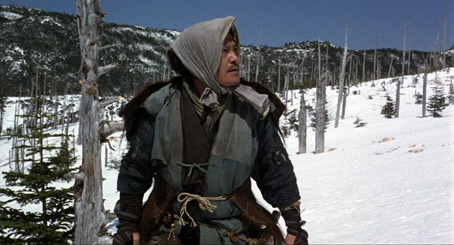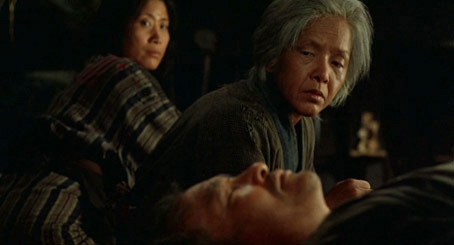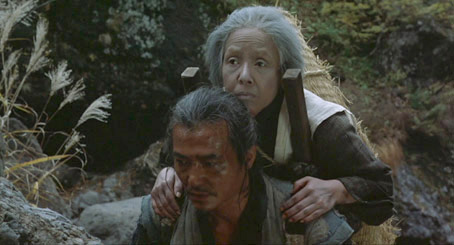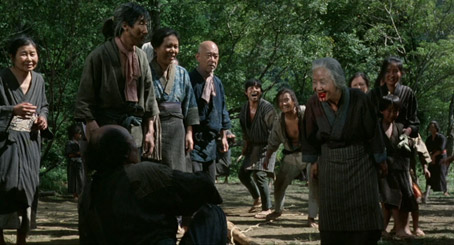|
It is, I would suggest, almost impossible for someone raised in an age of technological mass communication to imagine what it is like to live in a community that is completely isolated from the outside world. I'm certainly not sure I can, despite having spent my early years in a village in which I knew no-one my own age. But we still had a telephone, there was a bus stop right outside the house, and the nearest town was only a three mile cycle ride away. And we had television and newspapers to keep us in touch with what was happening in the world at large. No, for true isolation you ideally need to nip back a couple of hundred years, to a time of remote, self-sufficient farming villages, whose inhabitants seemed to manage without the interference of outsiders.
Such communities have certainly proved popular with filmmakers over the years, as subjects for ethnographic documentaries (from the 1930 Georgian Salt for Svanetia to the recent Darwin), as settings for offbeat dramas (Tulpan, Ten Canoes, Atanarjuat), or locations for terrorising unwary members of so-called civilised society (The Wicker Man, Deliverance). It's that second category that appears to have struck a chord with Japanese maestro Imamura Shôhei, who in 1968 made the extraordinary Profound Desires of the Gods / Kamigami no Fukaki Yokubo, which focussed on a family who had chosen to live in social isolation on a fictional Okinawan island and who, as a consequence, had created an alternative culture with its own rules and traditions, one attractive enough to prompt a visiting engineer to abandon his work and join them.

An even stronger sense of societal isolation pervades Imamura's 1983 film The Ballad of Narayama [Narayama-bushi kô], which is set in a remote mountain village in the late 19th century, one that the opening aerial shots suggest you'd need a not-yet-invented helicopter to reach from the outside. Its inhabitants lead a simple but self-sufficient existence, their lives governed by laws of their own devising, one of which stipulates that when a person reaches 70 years of age they become subject to ubasute, which requires them to be carried to the top of the nearby Narayama mountain and left there to die, clearing community space for the next generation. It's a kind of Logan's Run for the elderly, one seemingly born of legend that many older Japanese believe was once historical fact.
As with Profound Desires (the two films have a lot more in common than communal isolation), the focus of the film is a single family, one whose matriarch Orin is approaching her 70th birthday but who still has the smarts and stamina of a woman half her age. She lives with and presides over her two grown sons, the widowed Tatsuhei and the malodorous Risuke, as well as Tatsuhei's two sons Kesakichi and Tomekichi. What unfolds is not so much a story, at least in the traditional sense, but an intimate portrait of the family and village life over the course of the final year of Orin's allotted time on earth. There is nonetheless an underlying narrative purpose to much of what occurs, with almost every scene in some way linked to Orin's upcoming departure. Even her participation in the severe punishment of a family accused of theft serves a dual narrative purpose, illustrating both the unforgiving nature of the village's moral code and Orin's own staunch belief in its importance to the community's stability and continued survival. A pragmatic traditionalist, she accepts her prescribed fate and spends her final months quietly settling her family's affairs and preparing their future needs. This includes arranging a new wife for Tatsuhei, and a sexual partner – if only for one night – for her son Risuke, whose foul body odour repels even a widow who has agreed to sleep with every man in the village to atone for her late husband's sins. Orin's determination to convince her family that her time has come extends to smashing out her front teeth, which until then have been symbolic of her lingering youth and fitness.

With its single family focus, its fascination with primitivism, and the direct parallels drawn between human and animal behaviour, The Ballad of Narayama is an organic companion piece to Profound Desires of the Gods. But where the isolation of Profound Desires was both voluntary and tenuous, in Ballad of Narayama it is geographically enforced, creating a micro-society whose approach to law enforcement is, by modern standards, borderline barbaric. But in a community in which you can only eat what you grow, food theft is regarded as the most serious crime of all, one that sees an entire family of transgressors, irrespective of age or gender, dragged from their home and thrown into a pit to be buried alive (a sequence that is covered in a single wide shot, prompting some small concern for the actors who are visibly buried beneath the earth). It's a decision taken easily and in the villagers' view logically, a development from an earlier scene in which the coded announcement of the apprehension of three thieves prompts every villager, Orin included, to instinctively grab a weapon and assemble for punitive action.
Such behaviour, of course, is not consigned to history, and has its modern equivalent in the punishment dished out for so-called Hadd offences under Sharia law. And like this modern fundamentalist successor, the code of the village has no room for sentiment. The younger Tatsuhei, we learn, killed his own father for refusing to carry out his own ubasute duties, and being pregnant with the child of the son of your accuser proves no protection when it comes to the punishment for stealing from others. Harsh laws have grown from a harsh existence, one where a failed food crop could wipe out the entire population and where unwanted babies are discarded at birth. It's a way of life reflected in the directness of Imamura's approach, from the frank and unembarrassed portrayal of sex to the non-judgemental handling of the community's tough justice. It all builds to a hypnotic final act in which Tatsuhei dutifully carries his mother up the Narayama mountain, a tough and potentially perilous journey that village law dictates should be undertaken in silence. As Orin is left to her fate by a son torn between his emotions and his sense of duty, we are left with a real sense of waste and injustice, and the worry that this custom has a present-day equivalent, one where the cold isolation of the mountain top is replaced by the homogenised and impersonal environment of the modern care home.

From its earliest scenes, The Ballad of Narayama exerts a strange but captivating hold, one I've had real trouble explaining to others without sounding woolly and confused, which is part of the reason for the spectacularly late arrival of this review (that and misplacing the review disc in a disorganised move). With storytelling on the back burner, the meat of the film lies in the character and ethnographic detail, in its metaphoric and socio-political bite, and its sometimes striking symbolism. Some have balked a little at Imamura's sometimes unflinching approach, but even at its most extreme – a discarded baby is shown lying in a field and is ultimately left there for its properties as fertiliser – it feels appropriate to the story and never gratuitous. And for all the portrayed hardships, this is no downbeat experience, with the villagers' lively and often upbeat approach to life reflected in the energy and poetry of Imamura's handling and the moments of dark and even absurdist humour (the rabbit that is shot and is then snatched by a hawk before its hunter can reach it is a personal favourite).
The Ballad of Narayama is a rare example of a remake that eclipses a strong original (Fukazawa Shichirô's source novel received more stylised handling back in 1958 from Kinoshita Keisuke), a frank and thematically complex portrait of isolated mountain village existence brought vividly to life by Imamura's direction, Tochizawa Masao's nature-toned cinematography, and a consistently engaging cast, one that suffered for its art by working and living in conditions not far removed from those shown on screen. Hidari Tonpei's kinetic excitability as Risuke is nicely balanced by Ogata Ken's more emotionally controlled Tatsuhei, but the top honours go to Sakamoto Sumiko, who although just 47 is utterly convincing as the 69-year old Orin, and in an act of commitment that far surpassed the call of duty, had her front teeth removed to assist the conviction of her portrayal. Now how many white smiling Hollywood stars do you think would agree to that?
The Ballad of Narayama is a film whose colours reflect the changing seasons. Many of the scenes have an earthy hue, a visual reflection of the film's fascination with the interrelationship between humans and their natural surroundings, and many take place at night, under cloud, or in dimly lit interiors. This does mean that the image doesn't pop from the screen in the way that the Blu-ray of the sunshine-soaked Profound Desires of the Gods did, but this is still an impressive transfer from a good quality original, one whose well balanced contrast achieves solid black levels, even in dimmer interiors, without sacrificing too much in the way of shadow detail. The lack of traditional high-key lighting for night exteriors means that a few sequences can look dark on even a well calibrated screen, at least when watched in daylight, but in more ideal viewing conditions the image is clearly visible and appropriately graded. Although not immediately evident in the dimmer exteriors or night scenes, the level of detail is consistently good, and the colour rendition feels about right, without any hint of over-saturation. Film grain is visible, but is not in any way intrusive.

There are a couple of minor pops under the opening Toei logo, but otherwise the lossless DTS-HD Master Audio 2.0 Japanese mono soundtrack is clear and free of obvious damage. The frequency range is a little narrower than you might expect from a 1983 studio production, but there is no background hiss and the dialogue and music are both distortion-free.
Tony Rayns on The Ballad of Narayama (19:16)
The venerable Mr. Rayns provides a typically comprehensive introduction to the film, placing it in the context of Imamura's career, providing detail on how it differs from its 1958 predecessor and how Imamura incorporated elements from two Fukazawa novels. The mountain location and the cast are discussed, and we also get to hear Imamura's original plan for the opening scene, which would have emphasised the parallels with modern-day treatment of the elderly.
The are also four Japanese trailers, two of them pre-release teasers. All are in good shape, but switch to the main feature immediately after watching them and you'll really appreciate the quality of the that transfer.
Japanese Teaser #1 (2:17) includes footage that would be considered risqué by UK trailer standards and assures us that this is a film about "Life and death and sex and laughter."
Japanese Teaser #2 (1:06) is a more subtle affair, using the image of intertwining snakes to suggest "a world of passions." It also includes a couple of shots of Imamura at work on the film.
Japanese Trailer #1 (2:51) could potentially dissuade the squeamish by including the tooth smashing shot, but does assure us that the film is "an emotional masterpiece" and that it was "3 years in the making."
Japanese Trailer #2 (2:31) spares us the teeth bashing and includes a brief shot of the cast and crew boarding the helicopter required to transport them to the mountain location. I knew it.
Finally we have the always welcome Masters of Cinema Booklet, which this time dispenses with critical essays on the film to focus on the words of the filmmakers themselves, which in the absence of filmed interviews I heartily welcome. Included are a Director's Statement by Imamura, an interview with Imamura conducted by Max Tessier, a production diary by Imamura's regular producer Tomoda Jirô, and an anonymous offering from the tenth-century poem-tale Yamato monogatari that outlines the ubasute legend, plus the main film credits, high quality stills and the usual advisory notes on setting your TV correctly. Everything here is worthy of your time, but the interview with Imamura, which originally appeared in La Revue du cinéma – Image et son, and Tomoda Jirô's production diary are essential and enlightening reads.
I've alluded to this more than once above, but there is a very real sense that The Ballad of Narayama is, thematically speaking, the tougher, darker brother of the director's 1968 Profound Desires of the Gods. Certainly they make convincing companion pieces, but are different enough in tone and content to have their own very distinct identities, and Ballad certainly goes its own way in its haunting final act. Though some have found some of the content disturbing – I've seen the film described more than once as being difficult to watch – I have never found it so, but that may say as much about me as it does about the film. It is, without doubt, a uniquely Imamura work, one as rich in character detail and social observation as anything in his oeuvre, and a most worthy Cannes Palme D'Or winner. The film has never looked better than it does on the Blu-ray in this Masters of Cinema's dual format release, and while not overloaded with extras, the Tony Rayns intro and the excellent booklet will do me just fine. Recommended.
|